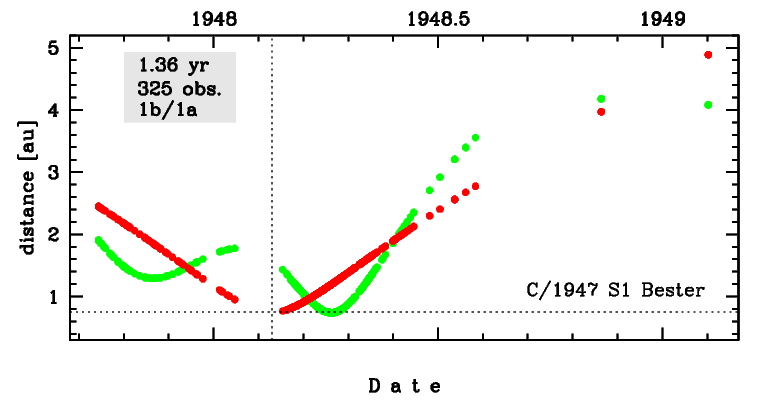C/1947 S1 Bester
more info
Comet C/1947 S1 was discovered on 25 September 1947 by Michiel J. Bester (Boyden Station of Harvard College Observatory, Bloemfontein, South Africa), that is about 4.7 months before perihelion passage, and the comet was last seen on 6 February 1949. [Kronk, Cometography: Volume 4].
This comet made its closest approach to the Earth on 5 April 1948 (0.740 au), that is about 1.5 month after its perihelion passage.
Solutions given here are based on data spanning over 1.356 yr in a range of heliocentric distances from 2.449 au through perihelion (0.748 au) to 4.890 au.
Pure gravitational orbit determined from the available positional measurements (325 observations) give 1a-class orbit.
It was possible to determine the non-gravitational orbit for C/1947 S1 (preferred orbit) where a small decrease of RMS was obtained (from 2.59 arcsec to 2.42 arcsec).
This Oort spike comet suffers moderate planetary perturbations during its passage through the planetary system that lead to escape the comet from the solar system on a hyperbolic orbit (see future barycentric orbits for both models of motion).
More details in Królikowska et al. 2014.
This comet made its closest approach to the Earth on 5 April 1948 (0.740 au), that is about 1.5 month after its perihelion passage.
Solutions given here are based on data spanning over 1.356 yr in a range of heliocentric distances from 2.449 au through perihelion (0.748 au) to 4.890 au.
Pure gravitational orbit determined from the available positional measurements (325 observations) give 1a-class orbit.
It was possible to determine the non-gravitational orbit for C/1947 S1 (preferred orbit) where a small decrease of RMS was obtained (from 2.59 arcsec to 2.42 arcsec).
This Oort spike comet suffers moderate planetary perturbations during its passage through the planetary system that lead to escape the comet from the solar system on a hyperbolic orbit (see future barycentric orbits for both models of motion).
More details in Królikowska et al. 2014.
| solution description | ||
|---|---|---|
| number of observations | 325 | |
| data interval | 1947 09 28 – 1949 02 06 | |
| data type | perihelion within the observation arc (FULL) | |
| data arc selection | entire data set (STD) | |
| range of heliocentric distances | 2.45 au – 0.75 au (perihelion) – 4.89 au | |
| type of model of motion | NS - non-gravitational orbits for standard g(r) | |
| data weighting | YES | |
| number of residuals | 543 | |
| RMS [arcseconds] | 2.42 | |
| orbit quality class | 1b | |
| orbital elements (heliocentric ecliptic J2000) | ||
|---|---|---|
| Epoch | 1948 02 19 | |
| perihelion date | 1948 02 16.42230919 | ± 0.00013783 |
| perihelion distance [au] | 0.74810617 | ± 0.00000196 |
| eccentricity | 1.00023485 | ± 0.00001240 |
| argument of perihelion [°] | 350.213385 | ± 0.000206 |
| ascending node [°] | 271.439361 | ± 0.000208 |
| inclination [°] | 140.568516 | ± 0.000062 |
| reciprocal semi-major axis [10-6 au-1] | -313.92 | ± 16.58 |
| non-gravitational parameters | ||
|---|---|---|
| A1 [10-8au/day2] | 2.055 | ± 0.207 |
| A2 [10-8au/day2] | -2.3409 | ± 0.0649 |
| A3 [10-8au/day2] | 0 | (assumed) |
| m | -2.15 | |
| n | 5.093 | |
| k | -4.6142 | |
| r0 [au] | 2.808 | |
| α | 0.1113 | |
